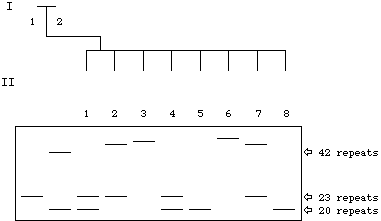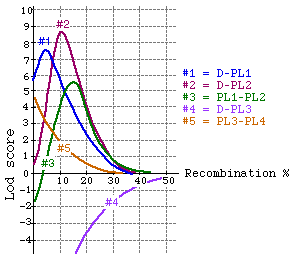A certain X-linked dominant disease in humans occurs when there are more than 40 repeats of a CGG trinucleotide in a particular gene. The unique sequence outside the repeat region is as follows:
- 5' CAGTATGCA------(CGG)n-------ATGCGTAAT 3'
- 3' GTCATACGT------(GCC)n-------TACGCATTA 5'
In the lab freezer, you find 5 primers of different sequences (listed below). If you wanted to use PCR to amplify the trinculeotide repeat region, which of these primers would you use?
- Primer:
- #1) 5'-GTCATACGT-3'
- #2) 5'-ATTACGCAT-3'
- #3) 5'-ATGCGTAAT-3'
- #4) 5'-CAGTATGCA-3'
- #5) 5'-TGCATACTG-3'
- #1) 5'-GTCATACGT-3'
Shown below are the outline of a pedigree for the disease described above, and a representation of a gel showing PCR-amplified fragments detecting the number of CGG repeats. The DNA corresponding to each individual is directly below his or her place in the pedigree. Based on the information you have been given, fill in the pedigree to show the sex of the individual as well as the phenotype (affected vs. unaffected).


